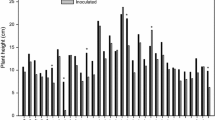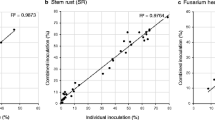Abstract
Wilt of sugarcane caused by Fusarium sacchari is a serious disease affecting cane stalks in the crop. The disease affects the plant during any period of the crop cycle, decreasing agricultural and industrial production. Managing the disease through resistant varieties is considered as the most sustainable and economically viable approach. However, there is a lack of a versatile disease rating system for F. sacchari resistance in sugarcane. To address the issue, we developed a mean wilt severity index on a 0–9 rating scale. In the revised wilt severity system, essential criteria governing wilt were taken into account to develop 0–9 rating scale as resistant, moderately resistant, moderately susceptible, susceptible and highly susceptible corresponding to 0–2.0, 2.1–4.0, 4.1–6.0, 6.1–8.0 and 8.1–9.0 scores, respectively, based on overall wilt expression in sugarcane. This new scale clearly discerns the varietal reactions based on internal symptoms, especially pith region cavities, cane and spindle leaf phenotype and disease progress through nodes and roots. This system of grading based on 0–9 scale was found better than the previous numeric index system which grouped clones into 4 grades, ignoring the relative importance of nodal transgression and pith cavity development. This new scale is applicable to grade sugarcane genotypes after plug method of inoculation or disease development screening through soil application of F. sacchari inoculum.





Similar content being viewed by others
References
Agnihotri, V.P. 1983. Diseases of sugarcane. New Delhi: Oxford and IBH publishing Co.
Butler, E.J., and A.H. Khan. 1913. Some new sugarcane diseases. Part I, Wilt. Memoirs of Department of Agriculture, India, Botany Series 6: 180–190.
Hossain, M.I., M.S. Rahman, M.E. Reza, and M.O. Khaiyam. 2017. Screening of some sugarcane genotypes to wilt. American Journal of Plant Biology 2 (4): 125–128.
Kirtikar, K.R., G.P. Singh, and R. Shukla. 1972. Role of seed material in carryover of wilt disease of sugarcane. Indian Sugar 22: 89–90.
Mohanraj, D., and K.C. Alexander. 1984. A qualitative numerical index for rating severity in sugarcane wilt. Indian Sugar Crops Journal 10: 9–20.
Parthasarathy, S.V. 1972. Sugarcane in India. Vuyyuru: KCP Publishers.
Patil, A.S., S.L. Patil, and D.G. Hapase. 1992. Wilt diseases of sugarcane in India. Proceedings of International Society of Sugar Cane Technologists 21: 346.
Sarma, M.N. 1976. Wilt disease of sugarcane. Sugarcane Pathologist’s Newsletter 15 (16): 30–33.
Srinivasan, K.V. 1964. Some observations on sugarcane wilt. Journal of Indian Botanical Society 43: 397–408.
Viswanathan, R. 2012. Sugarcane diseases and their management. Coimbatore: Sugarcane Breeding Institute.
Viswanathan, R. 2010. Plant disease: Red rot of sugarcane. New Delhi: Anmol Publishers.
Viswanathan, R. 2013. Status of sugarcane wilt: One hundred years after its occurrence in India. Journal of Sugarcane Research 3 (2): 86–106.
Viswanathan, R. 2020. Fusarium diseases affecting sugarcane production in India. Indian Phytopathology 73: 415–424.
Viswanathan, R., C.G. Balaji, R. Selvakumar, P. Malathi, A.R. Sundar, A. Annadurai, A.S. Pazhany, K. Manivannan, and R. Nithyanantham. 2019. Identification of sources of resistance to wilt caused by Fusarium sacchari in Indian sugarcane parental population. International Sugar Journal 121: 838–846.
Viswanathan, R., C.G. Balaji, R. Selvakumar, P. Malathi, A.R. Sundar, C.N. Prasanth, M.L. Chhabra, and B. Parameswari. 2017. Epidemiology of Fusarium diseases in sugarcane: A new discovery of same Fusarium sacchari causing two distinct diseases, wilt and pokkah boeng. Sugar Tech 19: 638–646.
Viswanathan, R., P. Malathi, A. Annadurai, C.N. Prasanth, and M. Scindiya. 2014. Sudden occurrence of wilt and pokkah boeng in sugarcane and status of resistance in the parental clones in national hybridization garden to these diseases. Journal of Sugarcane Research 4 (1): 62–81.
Viswanathan, R., P. Malathi, A.R. Sundar, M. Poongothai, and N. Singh. 2006. Current status of sugarcane wilt in India. Sugar Cane International 24 (4): 1–7.
Viswanathan, R., M. Poongothai, and P. Malathi. 2011. Pathogenic and molecular confirmation of Fusarium sacchari causing wilt in sugarcane. Sugar Tech 13: 68–76.
Viswanathan, R., M. Poongothai, P. Malathi, and C.N. Prasanth. 2015. Sugarcane wilt: Simulation of pathogenicity through different methods and environments. International Sugar Journal 117: 286–293.
Viswanathan, R., M. Poongothai, P. Malathi, and A.R. Sundar. 2012. Sugarcane wilt: New insights into the pathogen identity, variability and pathogenicity. In Functional plant science and biotechnology 6 (Special Issue 2), ed. R. Viswanathan and A.R. Sundar, 30–39. Ikenobe: Global Science Books.
Viswanathan, R., and G.P. Rao. 2006. Developing disease resistant varieties and methods of disease screening in sugarcane. In Sugarcane: Crop production and improvement, ed. S.B. Singh, G.P. Rao, S. Solomon, and P. Gopalasundaram, 759–800. LLC Houston: Studium Press.
Viswanathan, R., R. Selvakumar, N. Geetha, C.G. Balaji, A. Annadurai, Adhini S. Pazhani, P. Malathi, A.R. Sundar, R. Nithiyanantham, and K. Manivannan. 2021. Epidemiology of sugarcane wilt: Predisposition by root borer Polyocha depresella a myth or reality. Indian Phytopathology. https://doi.org/10.1007/s42360-021-00398-0.
Acknowledgements
The authors are thankful to the Directors of ICAR-Sugarcane Breeding Institute, Coimbatore for extending necessary field and laboratory facilities to carry out this research work.
Funding
The financial support has been received from the Institute’s budget and no specific grants received from outside agencies.
Author information
Authors and Affiliations
Corresponding author
Ethics declarations
Conflict of interest
The authors declare that they have no conflict of interest.
Human and Animals Rights
The present research did not involve human participants and/or animals.
Informed Consent
Informed consent was obtained from all individual participants included in the study.
Additional information
Publisher's Note
Springer Nature remains neutral with regard to jurisdictional claims in published maps and institutional affiliations.
Rights and permissions
About this article
Cite this article
Viswanathan, R., Selvakumar, R., Malathi, P. et al. Modified Scale for Evaluating Sugarcane Clones for Fusarium wilt Resistance with Plug Method of Inoculation. Sugar Tech 24, 502–512 (2022). https://doi.org/10.1007/s12355-021-01044-9
Received:
Accepted:
Published:
Issue Date:
DOI: https://doi.org/10.1007/s12355-021-01044-9




